Well now that I’m done procrastinating on this it’s time to get to it… because I’m procrastinating on other things. (Yes, I realize this is way overdue. Apologies to everyone who was waiting on this!)
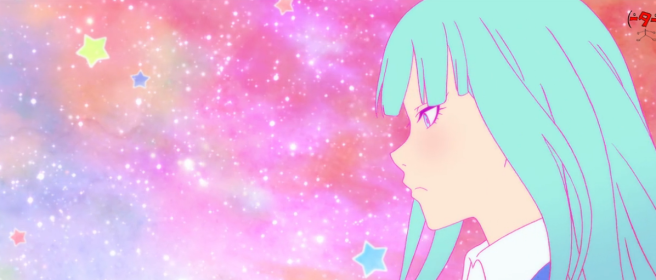 Our protagonist gloomily stands on the very end of her boat, staring into the crystal clear waters below her. There is a stark contrast between the technicolour paradise that is her imagination and the restrictive, hardened world on the other side. The music shifts in tone to indicate that — from bubblegum pop to a barren, almost macabre nursery rhyme-esque tune. The lyrics themselves reference a state of limbo.
Our protagonist gloomily stands on the very end of her boat, staring into the crystal clear waters below her. There is a stark contrast between the technicolour paradise that is her imagination and the restrictive, hardened world on the other side. The music shifts in tone to indicate that — from bubblegum pop to a barren, almost macabre nursery rhyme-esque tune. The lyrics themselves reference a state of limbo.
 As she falls — rather, floats — into the water her clothes rip off her body in a way reminiscent of mahou shoujo henshins, the flashy transformations that are a staple in every magical girl anime. Her sullen expression, however, indicates that this isn’t the empowering, joyous transformation sequence most magical girls experience. She dislikes the real world, so perhaps her transformation is representative of the mask she puts on in her daily life: a glamorous facade disguising the brokenness inside her with frills and ribbons.
As she falls — rather, floats — into the water her clothes rip off her body in a way reminiscent of mahou shoujo henshins, the flashy transformations that are a staple in every magical girl anime. Her sullen expression, however, indicates that this isn’t the empowering, joyous transformation sequence most magical girls experience. She dislikes the real world, so perhaps her transformation is representative of the mask she puts on in her daily life: a glamorous facade disguising the brokenness inside her with frills and ribbons.
She descends into the real world like a science fiction angel (that was my first thought, anyway). The area is populated like a video game — reused faceless sprites of a generic schoolgirl and a generic salaryman, grey and colorless like the buildings around them, a reflection of the way she views reality. It is of note that every single person is staring intently at their smartphones, not an uncommon sight even in reality, and everyone is unaware of her technicolor presence.
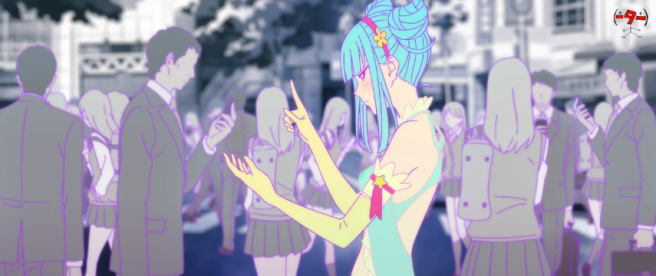 She mimes swiping on a smartphone, a movement akin to that of magicians casting spells with a flick of their wrists. In a way, one’s escape from reality by “entering” that of the Internet via their mobile phones can be said to be a kind of protective charm, a magical barrier that can be put up by anyone in order to step away from the harshness of real life. In the case of enjo kosai, the mobile phone is the magical link between two parties — salaryman and high school girl.
She mimes swiping on a smartphone, a movement akin to that of magicians casting spells with a flick of their wrists. In a way, one’s escape from reality by “entering” that of the Internet via their mobile phones can be said to be a kind of protective charm, a magical barrier that can be put up by anyone in order to step away from the harshness of real life. In the case of enjo kosai, the mobile phone is the magical link between two parties — salaryman and high school girl.
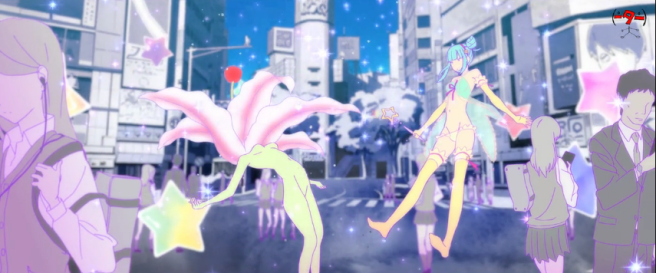 With this, she summons forth her magical bubble wand and sets about “correcting” the bland and boring city. With a tap on the nose, the face of a schoolgirl shrivels up and then blooms into one of the flowers present in the earlier half of the song, a ripe, red apple dangling between petals. I’m still a little unclear what this is supposed to represent — that she knows the truth (the apple) exists, but refuses to take a bite? That she’s trying to disguise reality by prettying it up with flowers, shooting stars and colors, but is unable to completely hide its existence? I have no clue. Still, it’s a disturbing yet beautiful image, much like this music video.
With this, she summons forth her magical bubble wand and sets about “correcting” the bland and boring city. With a tap on the nose, the face of a schoolgirl shrivels up and then blooms into one of the flowers present in the earlier half of the song, a ripe, red apple dangling between petals. I’m still a little unclear what this is supposed to represent — that she knows the truth (the apple) exists, but refuses to take a bite? That she’s trying to disguise reality by prettying it up with flowers, shooting stars and colors, but is unable to completely hide its existence? I have no clue. Still, it’s a disturbing yet beautiful image, much like this music video.
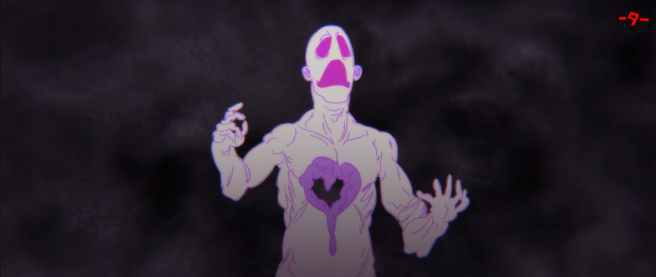 The next scene really struck a chord in me. The protagonist looks through the film in her wand and sees the true form of one of the salarymen — a sad, harrowed looking subhuman creature, that first glances about in desperation and embarrassment. He then digs into his chest, pulling out chunks of flesh until only a hollow, heart-shaped crevice remains. This one is pretty straightforward, I’m assuming it’s suggesting that the victims of this trade aren’t just the high school girls, but the lonely salarymen who don’t know how to or can’t pursue proper relationships because of their low self esteem or other problems. The ones that desire connections (sexual, romantic, or just plain affection) so much that they’re willing to fork out money for cheap imitations*. It’s sad, because what they have paid for isn’t “real love”, or anything even remotely similar to it. It’s an empty, soulless transaction.
The next scene really struck a chord in me. The protagonist looks through the film in her wand and sees the true form of one of the salarymen — a sad, harrowed looking subhuman creature, that first glances about in desperation and embarrassment. He then digs into his chest, pulling out chunks of flesh until only a hollow, heart-shaped crevice remains. This one is pretty straightforward, I’m assuming it’s suggesting that the victims of this trade aren’t just the high school girls, but the lonely salarymen who don’t know how to or can’t pursue proper relationships because of their low self esteem or other problems. The ones that desire connections (sexual, romantic, or just plain affection) so much that they’re willing to fork out money for cheap imitations*. It’s sad, because what they have paid for isn’t “real love”, or anything even remotely similar to it. It’s an empty, soulless transaction.
*BTW, I’m not sympathizing with any participants of enjo kosai that end up committing abuse, rape, pedophilia or other crimes because of weird fetishes and whatnot. As far as I know, a significant amount of high school girls do this with consent. Paying for companionship is considered by many to be something shameful to do, and the fact that there exist people who are compelled to do so because of their inability to connect with others naturally (or other reasons that can’t be helped) is something that deserves a little sympathy. Don’t lynch me.
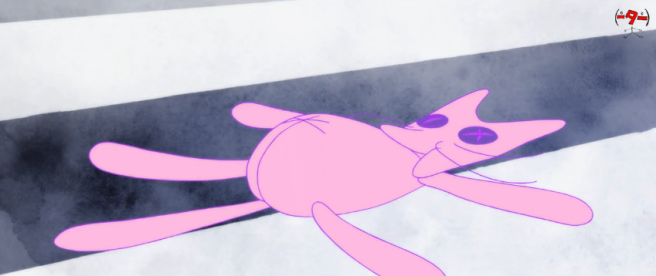 As the salaryman crumbles away, the cat eats a piece of him and transforms into a stuffed animal. This is interesting, and something I’ve just noticed — the cat starts off grayscale and, for lack of a better word, is real, like… it looks like a real cat (oh god my English is failing me), but upon ingesting the true form of the salaryman, turns into a limp, bright pink cat doll. Previously grayscale = reality and color = fantasy, so the cat is a bit of a contradiction. Interesting to note that its stuffed form has button eyes but lacks any other facial features.
As the salaryman crumbles away, the cat eats a piece of him and transforms into a stuffed animal. This is interesting, and something I’ve just noticed — the cat starts off grayscale and, for lack of a better word, is real, like… it looks like a real cat (oh god my English is failing me), but upon ingesting the true form of the salaryman, turns into a limp, bright pink cat doll. Previously grayscale = reality and color = fantasy, so the cat is a bit of a contradiction. Interesting to note that its stuffed form has button eyes but lacks any other facial features.
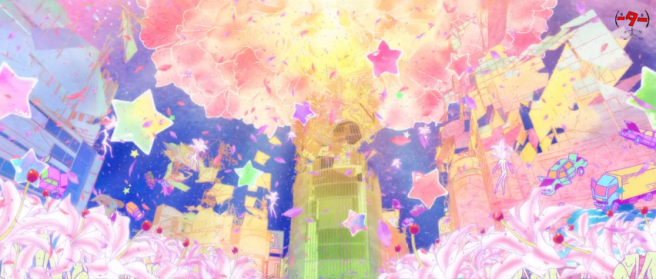 The world combusts in a sea of color, reminiscent of her fantasy from the first half. The giant building in the middle is kind of Yggdrasil-esque, but I might just be reaching here. There is a shot of a flower-high-school-girl stumbling around, having lost all her senses. Perhaps this suggests that this is a side effect of indulging too much in your fantasies. It numbs you and renders you helpless. The protagonist stares at her work, but doesn’t seem particularly happy about it — her face is expressionless and blank, as it has been throughout the video.
The world combusts in a sea of color, reminiscent of her fantasy from the first half. The giant building in the middle is kind of Yggdrasil-esque, but I might just be reaching here. There is a shot of a flower-high-school-girl stumbling around, having lost all her senses. Perhaps this suggests that this is a side effect of indulging too much in your fantasies. It numbs you and renders you helpless. The protagonist stares at her work, but doesn’t seem particularly happy about it — her face is expressionless and blank, as it has been throughout the video.
 She realizes that she isn’t alone (… besides the flower-people) as the couple from the first music video approach from the back, holding hands, with matching bracelets. They represent, in a sense, “true love” — in ME!ME!ME!, the male protagonist realizes that he has made a mistake giving up his girlfriend for his fantasies, or, well, that’s what the gist of it is. Although he is unable to break the cycle in the end, this image of them is before they split up, and captures them in a moment they are truly happy.
She realizes that she isn’t alone (… besides the flower-people) as the couple from the first music video approach from the back, holding hands, with matching bracelets. They represent, in a sense, “true love” — in ME!ME!ME!, the male protagonist realizes that he has made a mistake giving up his girlfriend for his fantasies, or, well, that’s what the gist of it is. Although he is unable to break the cycle in the end, this image of them is before they split up, and captures them in a moment they are truly happy.
The world around them reverts to its original state. Reality is not grayscale, as the protagonist envisions it, but colorful, bright and somewhat peaceful. What we have seen of the video since the beginning has been from the eyes of the protagonist — our visuals are tinted by her opinions and prejudice about the real world. Here, we realize that there isn’t really anything particularly horrifying about reality, it is not particularly bland or boring, just plain… normal. An objective viewpoint, if you will.
Here we see the first ever real emotion the protagonist shows — she reels back in horror, disgust almost, as she watches the couple proudly (?) display their affection. Maybe this is the “realization” that the video has been building up to, that she now finally knows that everything she has done up to this point is unreal, a hellish fantasy that pales in comparison to true love. She is crushed — and we once more enter her mind and see that everything has crumbled away.
The music video ends as it began — with her on her boat, this time naked, fragile, and surrounded by nothing but her stuffed cat. She is in the fetal position, one that connotes vulnerability and also: rebirth. She is not floating on sand, or water, but on… nothing, rendering her and her boat directionless, in a state of perpetual disorient.
An unknown figure approaches her — she looks up and smiles, her eyes filled with tears. The video ends here, ambiguous and vague, and quite unlike the first which was meant to be an endless loop. It is hence unknown if she does break the cycle of falling prey to her own fantasies. Who is this figure? There are no blatant clues, other than his masculine physique. Could it be another salaryman offering her an imitation of love? Or the Prince Charming she crafted out of her own desires, meant to save her from her despair and again plunge her headfirst into alternate realities? Or maybe an actual soulmate, acting as a bridge to bring her back to reality? Personally I would like to be optimistic and think it’s the latter, but the music video is vague for a reason, and I think it’s up to the individual’s interpretation whether or not the protagonist has a happy ending.
I hope my analysis made sense, even though I’m pretty sure it’s not 100% coherent. I’m anxiously awaiting another installment in this series, I’ve heard rumors that this is a trilogy.
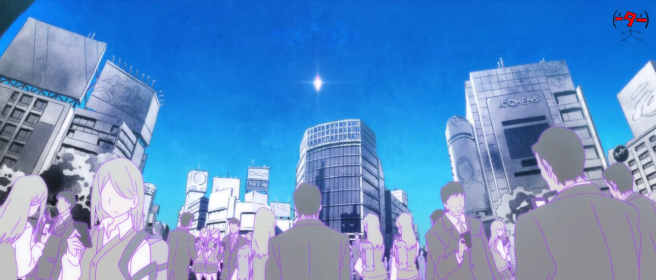
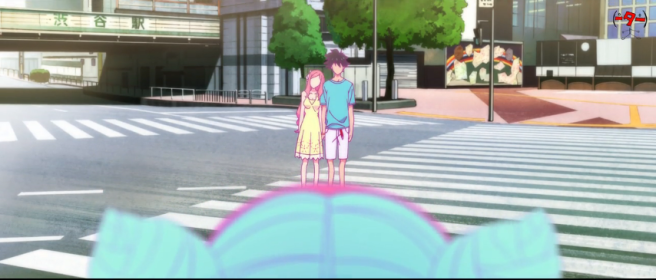

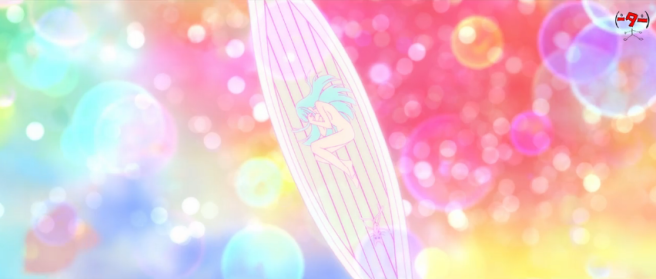
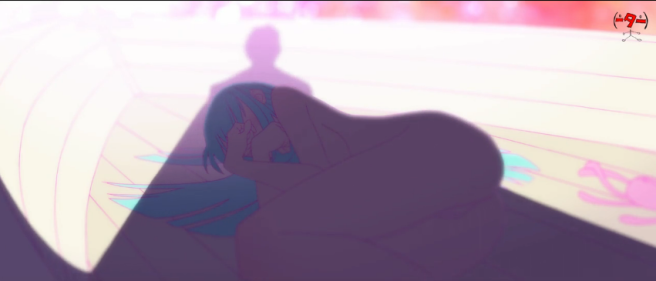
Great analysis! Brought up some perspectives I’ve never really thought about, especially with the final couple scenes.
LikeLiked by 1 person
Amazing! Thanks you so much for doing this
LikeLike
Great analysis, you gave a lot of new ways to see the emotion and understanding behind this video. Made me want to look up more about this video!
But there was something I think you weren’t aware of. The average Japanese man has to work 10-14 hours everyday, this means if they have partner they only see them a small while per day. Because of that they need to rely on other means to receive love and affection. Which is one of the reasons why men go along with compensated dating.
I thought that the scene where the salary man is seen-through the wand could be seen as him being unable to love someone properly due to his work circumstances and lack of opportunities from the effect of them. Based on that, In it’s own way, it could also reflect back to how this girl is similar to him and cannot find proper love, so she reduces herself to being with stranger to find any form of a caring relationship with someone to help her.
Sorry to nitpick, but I’m currently on a hunt for more observations from this video so I couldn’t stop myself.
LikeLike
There was also another thing that I was thinking of. The flower.
It’s white, very similar to the Lily (innocence and integrity in floriography I think…), with pink twinges… The white could symbolise innocence, but also, the pinkish hue at the edges could present childishness since it was so soft a colour. This could imply a state of unreadiness, or declare that the flower, although blossomed, has done so early. Therefore, the sexuality of the girl has been awakened prematurely.
The fact that it has a red apple present, particularly on its stamen, implies that the undigested truth of the ‘sin’ (the evil she does to herself by over exposure to sex or the very act of enjo kosai itself) now rules her sexuality. The stamen is the sticky end where the pollen is supposed to stick onto to fertilise the flower. Its absence, or rather the covering of it with the image of a plump juicy ‘Red Apple of the Knowledge Good & Evil’, exasperates the fact that she has overtly/inadvertently locked herself in a hell fantasy-bound that is controlled by sex/partners.
This is made even clearer by the transformed stumbling flower-head girls. The stumbling could literally mean that they ‘Fall into sin’ as well, their heads missing as they bumble and stumble everywhere in a very strange childlike nature, the flower-girls have turned into the physical embodiment of what the blue haired girl feels like (since everything around her expresses emotion despite her apathy): A fumbling idiot whom is solely controlled by the state of their sexuality. Or their Salesmen’s attentions.
The blue haired girl, having been negatively affected by the act of enjo kosai transforms the girls of reality into herself symbolically. This is significant only because she still refuses, at this point, to identify with her problems/issues. The flower-girls are still identical to one another (just like they were in the grey-scale reality), and the blind cat she kept as a companion eats a piece of Salesman carcass which ultimately reduces it into a stuffed animal, unfeeling, unmoving, and still blind (but this time alluded to have sight with the presence of button eyes)– this strikingly and tragically never changes… The cat never returns to its original state and last shown lifelessly strewn in the boat along with the blue haired girl crying.
The flower itself is as the author of the article said: the plant’s sexual organ. So it’s only natural to assume that the flower relates directly to sexuality and love, or at least to the very least, how it is viewed by women explicitly.
Contrastingly, though one is shown adorning the pink haired girl’s head, it lacks a filament, stamen, or any parts of the organ (the flower) that alludes to fertilisation. It only has its petals: the purest and most expressive part of the flower. Which suggests that the love shared between the protagonist and the pink-haired girl was/is pure and needs no hypersexualisation to keep it going. The relationship is stable and doesn’t crumble due to fickleness or advertising sexuality.
The sight of this relationship, the flower different from her own, the blue haired girl’s fantasy crashes to her horror, realisation now shatters her world around her, etc.
I don’t know why, but I thought this part was rather interesting.
I also thought that the flowers were a quite creative, pretty way of explaining & presenting this loss of innocence and its simultaneous projection of it intermingled with hypersexualisation. A flower is just a flower indeed, but once fertilised, the petals fall off and the plant bears fruit. The type of fruit shown here was only the ‘Red Apple’.
The blue haired girl had to choose whether or not she wanted to bear the weight that fruit holds… And is she willing enough to have that flower (her sexuality) wither away with it.
It was an amazing secual to ME!ME!ME! I am glad it wasn’t so… um sexual? I guess… compared to the first one, lol
THAT had me shocked.
LikeLiked by 1 person
As far as the scene where “Girl” sees the salaryman through the wand, I interpreted it as her seeing men (specifically kind she “entertains”) as heartless husks that crumble when they are alone, indicated when he looks around desperately. Also the cat that follows her, I think it might be some kind of embodiment of the part of her that wants to stay within reality, seeing as it has a realistic-ish look to it. However once it eats a part of the man who she “saw the truth” of, it (she) gives up on reality, becoming a part of her fantasy instead. This could represent her withdrawing entirely into her fantasy since once the cat turned into an un-realistic doll, the whole world followed.
LikeLike
I actually thought the video might be about idol culture and how the young girls are highly sexualized in media but not allowed to form real relationships with men.
LikeLike
In the music video the boy wasn’t happy even though he was holding the hand of his girlfriend
Do you have an explanation for that ?
LikeLike
It could have been a reference to the first music video where the male protagonist started having doubts about his relationship with his girlfriend due to his addiction to pornography/otaku culture.
LikeLike
I believe that she is the flue haird girl in mememe and that she is the one who corrupted Shuu and made him leave his girlfriend Hana
LikeLike
Hi,
First of all, thanks for this post, is the only interpretation I’ve seen that doesn’t feel forced, and that provides a lot of useful information that helps the interpretation of this video.
I’d like to add some points:
– The percussion sound at 1:31, that is repeated at 4:18 when she has an orgasm. I guess that sounds means the transition between the different stages of mind girl has:
Heaven ( or ”the other side of the moon”) : Fantasy World
The place between heaven and Earth : Her mind accepting that fantasy can’t fulfill her but doesn’t want to accept reality
Earth : Real world , at least through her perception.
– The lyrics (at least during the first half) are the conversation between ”ideal girl” , the girl at THE OTHER SIDE OF THE MOON, and girl. The most beatiful part of the lyrics are:
What’s the flavor your time spent in? / Sweet? Spicy? Salty? Bitter? / Or is it poisonous?
– Ideal Girl represents addiction (this makes a parralel to Dark Hana from mememe) ; one of my favourite scenes is at 2:48 when she is playfully playing with the apple , almost as if mocking reality. Ideal Girl is the one tempting girl to abandon the boring reality:
(The scene focus on Girl watching the moon, trying to eat the apple) A lonely God / is trying to tell me….. / (The scene focus on ideal girl) Doesn’t it hurt to cry? / Don’t think about sad things.
And basically all the lyrics goes on this same direction.
– At 3:13, the cat yawns, that shows how bored / unfulfilled Girl feels even after that fantastic world she has created. Then she looks down on the cat, and , I may be imagining things, but it seems she is almost angry when she gets down on her knees and stab the world, trying to get a ”better and more powerful high”, as she (almost) repeats the lyrics from the beggining:
Everything I touch crumbles down as this is the end of the illusion / How many times have I rebuilt it?
– This video , as in the case of mememe, is also a loop, this are the lyrics during the final part of the video:
I beg for what I don’t have / For the things who have been broken for who knows how long / The me seen in a dream / But being able to see it in a dream made me glad.
Indulging too much in fantasy is an addiction ( as it is indulging too much in porn ) , so after not being able to deal with reality, the most probable thing is that she will keep repeating this cycle, or as the lyrics at the beggining says: ” How many times I have rebuilt it?”
Fuck, actually I realized I have so much to say about how the lyrics gives so much insight to what’s going on in the video, that I’m gonna write a whole article about this, especially because right now i’m in a situation similar to Girl : self indulging too much into my fantasy world. Anyway, as soon as I finish it I’ll let you know, I’d like your opinion on my interpretation.
LikeLiked by 1 person
Yes I think you make a lot of good points that I didn’t really think about before you pointed it out! About the song being partly a conversation, it’s also a reflection of how the protagonist is at conflict with herself and is not entirely content with her life and her actions. I think that the music and lyrics should be taken into consideration as much as the visuals when it comes to something like this 🙂 I’ve thought about dissecting the song lyrically as well but I haven’t been able to get around to doing it. I would love to read your analysis, let me know when it’s done! 🙂
LikeLiked by 1 person
I read in a few places that a lily is symbolic of yuri in Japan, and that sort of influenced me to have a very different interpretation of it: I saw it as the girl is struggling with her sexuality, and so is feeling a sort of frustration with her body and herself. But your interpretation connects the dots much better and makes more sense, in my opinion.
LikeLike
There was also another thing that I was thinking of. The flower.
It’s white, very similar to the Lily (innocence and integrity in floriography I think…), with pink twinges… The white could symbolise innocence, but also, the pinkish hue at the edges could present childishness since it was so soft a colour. This could imply a state of unreadiness, or declare that the flower, although blossomed, has done so early. Therefore, the sexuality of the girl has been awakened prematurely.
The fact that it has a red apple present, particularly on its stamen, implies that the undigested truth of the ‘sin’ (the evil she does to herself by over exposure to sex or the very act of enjo kosai itself) now rules her sexuality. The stamen is the sticky end where the pollen is supposed to stick onto to fertilise the flower. Its absence, or rather the covering of it with the image of a plump juicy ‘Red Apple of the Knowledge Good & Evil’, exasperates the fact that she has overtly/inadvertently locked herself in a hell fantasy-bound that is controlled by sex/partners.
This is made even clearer by the transformed stumbling flower-head girls. The stumbling could literally mean that they ‘Fall into sin’ as well, their heads missing as they bumble and stumble everywhere in a very strange childlike nature, the flower-girls have turned into the physical embodiment of what the blue haired girl feels like (since everything around her expresses emotion despite her apathy): A fumbling idiot whom is solely controlled by the state of their sexuality. Or their Salesmen’s attentions.
The blue haired girl, having been negatively affected by the act of enjo kosai transforms the girls of reality into herself symbolically. This is significant only because she still refuses, at this point, to identify with her problems/issues. The flower-girls are still identical to one another (just like they were in the grey-scale reality), and the blind cat she kept as a companion eats a piece of Salesman carcass which ultimately reduces it into a stuffed animal, unfeeling, unmoving, and still blind (but this time alluded to have sight with the presence of button eyes)– this strikingly and tragically never changes… The cat never returns to its original state and last shown lifelessly strewn in the boat along with the blue haired girl crying.
The flower itself is as the author of the article said: the plant’s sexual organ. So it’s only natural to assume that the flower relates directly to sexuality and love, or at least to the very least, how it is viewed by women explicitly.
Contrastingly, though one is shown adorning the pink haired girl’s head, it lacks a filament, stamen, or any parts of the organ (the flower) that alludes to fertilisation. It only has its petals: the purest and most expressive part of the flower. Which suggests that the love shared between the protagonist and the pink-haired girl was/is pure and needs no hypersexualisation to keep it going. The relationship is stable and doesn’t crumble due to fickleness or advertising sexuality.
The sight of this relationship, the flower different from her own, the blue haired girl’s fantasy crashes to her horror, realisation now shatters her world around her, etc.
I don’t know why, but I thought this part was rather interesting.
I also thought that the flowers were a quite creative, pretty way of explaining & presenting this loss of innocence and its simultaneous projection of it intermingled with hypersexualisation. A flower is just a flower indeed, but once fertilised, the petals fall off and the plant bears fruit. The type of fruit shown here was only the ‘Red Apple’.
The blue haired girl had to choose whether or not she wanted to bear the weight that fruit holds… And is she willing enough to have that flower (her sexuality) wither away with it.
It was an amazing secual to ME!ME!ME! I am glad it wasn’t so… um sexual? I guess… compared to the first one, lol
THAT had me shocked.
LikeLike
After she arrives on earth, when the music stops for a couple of seconds and then resumes with the girl having some sort of conversation… Although I have no idea of how “compensated dating” works, I imagine that would be the sort of things a girl engaging in that sort of thing would say to a lonely man seeking “love”.
LikeLike
Great,.
LikeLike
I think the person at the end is Shu.
In the shot with him and Hana, he was already looking kind of bored with the relationship. Maybe seeing this blue-haired girl piqued his interest, and also makes sense as this is the prequel to ME! As we know, Shu “lost” in his struggle, and gave up as the blue-haired girl kissed/consumed his dismembered body. I guess she could be seen as as yandere, but I’m guessing they just hadn’t originally planned to make another video from the succubus’ perspective.
I also think that perhaps Hana killed herself afterwards. No evidence, but her falling away to darkness could be interpreted both ways. Maybe it just means Shu is too far gone, but I think it would be more significant if it means she gave up too and he can’t ever see her again (like the picture shattering).
LikeLike